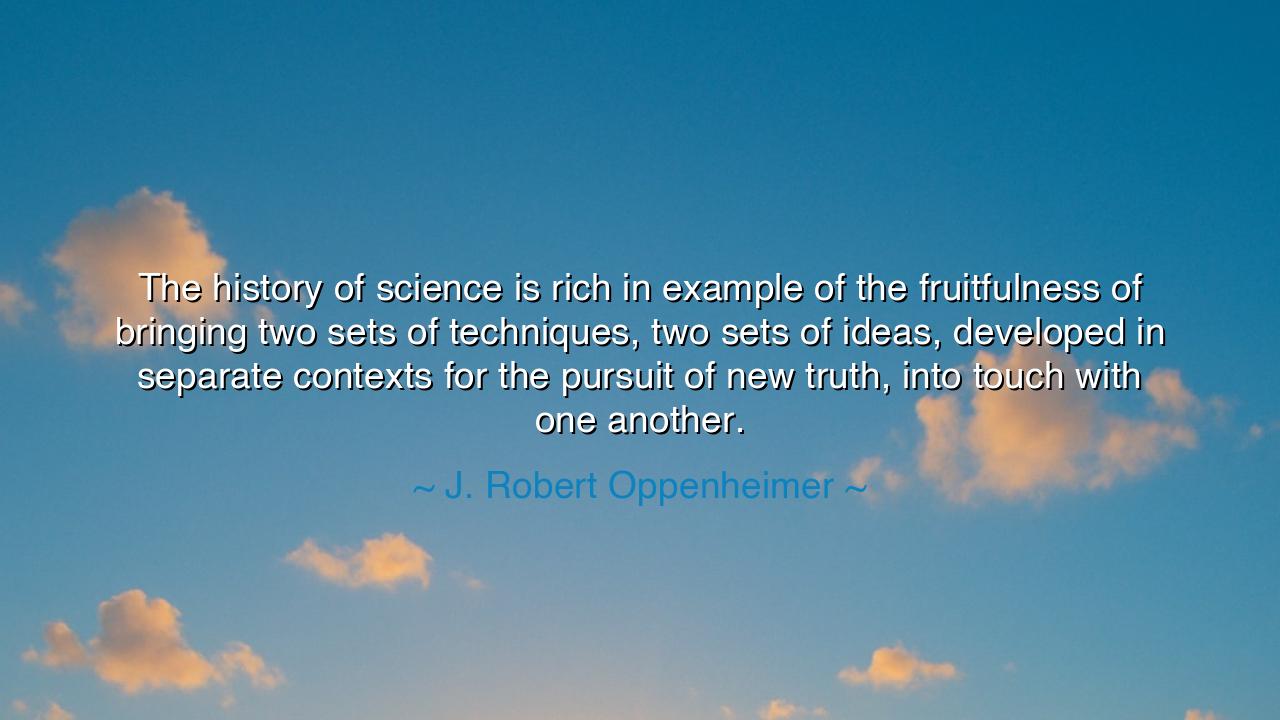
The history of science is rich in example of the fruitfulness of
The history of science is rich in example of the fruitfulness of bringing two sets of techniques, two sets of ideas, developed in separate contexts for the pursuit of new truth, into touch with one another.






In the profound and contemplative words of J. Robert Oppenheimer, the father of the atomic age and a man burdened by both genius and conscience, we hear a truth that transcends science itself: “The history of science is rich in example of the fruitfulness of bringing two sets of techniques, two sets of ideas, developed in separate contexts for the pursuit of new truth, into touch with one another.” In this declaration lies not merely an observation about discovery, but a philosophy of creation—a reminder that progress is born not in isolation, but in connection. Oppenheimer, a master of both physics and poetry, understood that knowledge grows like a tree whose roots intertwine with others; it flourishes when disciplines meet, when minds that once walked apart find unity in shared curiosity.
The origin of this quote can be traced to Oppenheimer’s reflections on the evolution of modern physics, a field that itself arose from the marriage of two once-distant worlds—mathematics and philosophy, experiment and imagination. In his lifetime, Oppenheimer stood at the crossroads of worlds: the ancient and the modern, the scientific and the moral. He lived in an era when quantum mechanics and relativity collided, reshaping the human understanding of matter and time. To him, this union of ideas symbolized not just the progress of science, but the eternal law of creation itself: that truth is revealed when opposites converge.
This principle is as old as civilization. When Isaac Newton, centuries before Oppenheimer, combined the precise measurement of mathematics with the mystical yearning to understand divine order, he discovered the laws of motion that bound heaven and earth. When James Clerk Maxwell merged electricity and magnetism, two forces once thought separate, he unveiled the invisible harmony of energy that moves through all things. And when the ancient Greeks united reason with wonder, philosophy with observation, they gave birth to the very idea of science. Thus, the fruitfulness of uniting ideas has always been the seed of every new dawn of understanding.
But Oppenheimer’s words carry a deeper wisdom beyond the laboratory. For he speaks not only of science, but of the human spirit. Every person, like every discipline, holds within them two sets of truths—one born of intellect, the other of emotion; one from the world, the other from the soul. When these meet, when the heart and the mind touch in harmony, then one glimpses a higher wisdom. The great achievements of humanity—art, philosophy, invention—are not the triumph of intellect alone, but the union of reason and imagination, of analysis and intuition. To create, one must bring together what has been divided, and in doing so, forge something that transcends both.
Consider the moment in history when Albert Einstein, a patent clerk surrounded by the mechanical devices of his age, dreamed of riding upon a beam of light. Out of that simple merging of fantasy and mathematics came the theory of relativity, and with it, a new vision of the cosmos. Oppenheimer himself embodied this union. Trained as a theoretical physicist, he was also a student of Sanskrit, a reader of the Bhagavad Gita, and a philosopher of the human condition. He saw no contradiction in this, for he knew that the quest for knowledge is both a scientific and spiritual journey. “Now I am become Death,” he would later quote, not as a boast, but as a meditation on the tragic convergence of wisdom and power, of knowledge and consequence.
And so, in Oppenheimer’s teaching, we find a call to integration. He reminds us that knowledge cannot flourish within walls—that no field, no art, no person grows whole in isolation. The progress of humanity depends upon dialogue, upon the meeting of worlds. A painter learns from a physicist’s study of light; a scientist draws inspiration from a poet’s sense of wonder. The boundaries between disciplines, between people, between cultures, are illusions that hinder the discovery of new truths. When we allow them to dissolve, creation becomes infinite.
The lesson, then, is clear and timeless: seek connection where others see division. Whether in science, art, or life itself, bring together what is separate. Let your curiosity be boundless and your mind open to ideas beyond your field or comfort. Learn from those unlike yourself. Unite the technical with the spiritual, the logical with the emotional, the precise with the profound. For only when we bring such opposites into harmony do we touch the true nature of truth—not as a possession, but as a living flame that grows brighter through the meeting of minds.
And so, my child, remember Oppenheimer’s wisdom as you walk the path of learning: truth is not found in solitude but in synthesis. The world awaits those who can weave together its divided threads. Be not afraid to cross boundaries, to merge what seems incompatible, for the universe itself was born from the collision of forces, and from that collision came the harmony we now call creation.






AAdministratorAdministrator
Welcome, honored guests. Please leave a comment, we will respond soon